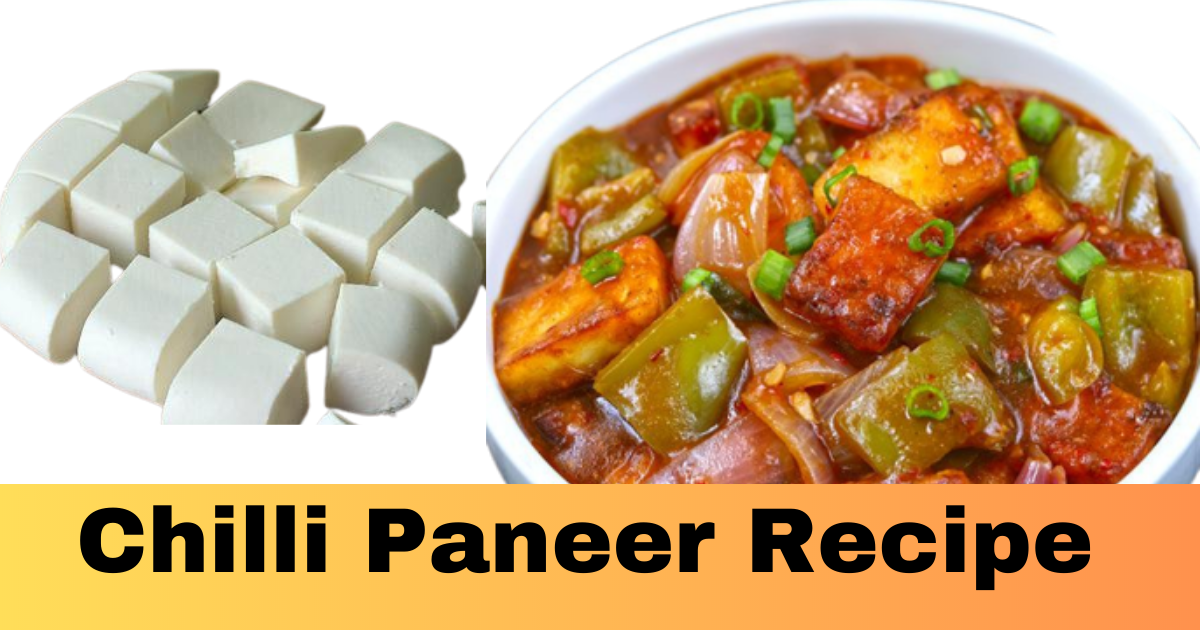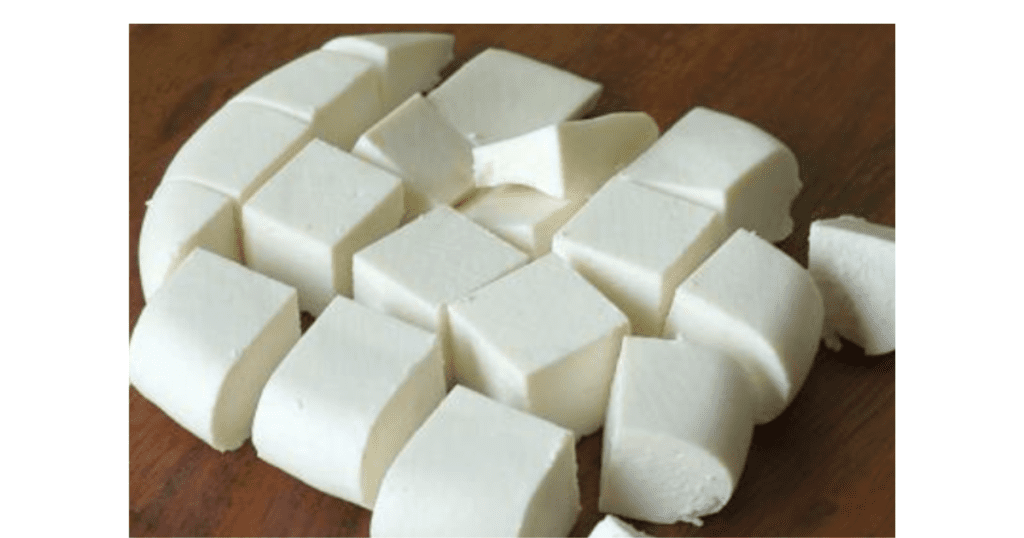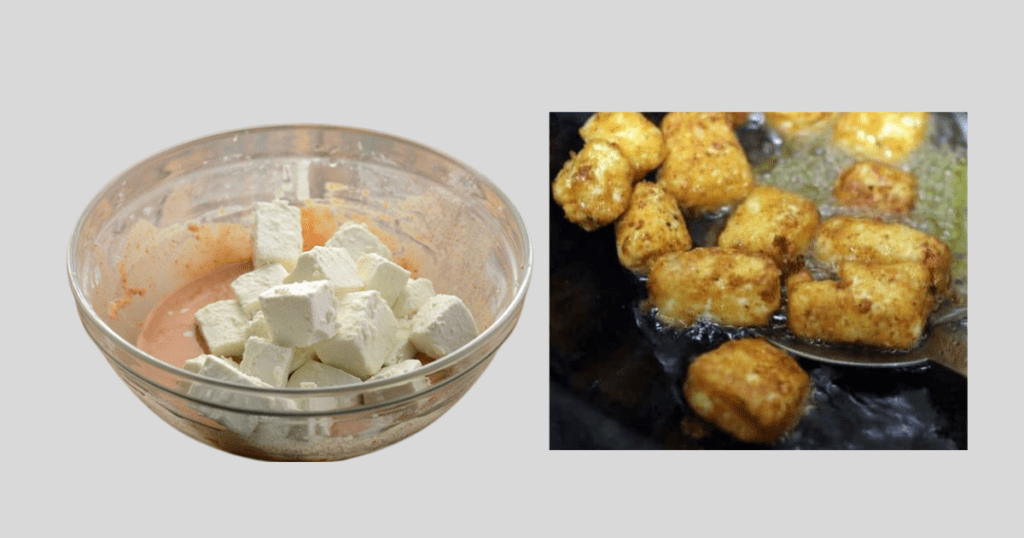With our Easy Homemade Chilli Paneer Recipe, you’re now equipped to embark on a culinary adventure that promises to deliver a flavorful delight to your taste buds. Chilli Paneer is a dish that never fails to excite the taste buds. The Chilli Paneer Recipe is a culinary gem that originated from the fusion of Indian and Chinese cuisines.
Easy Homemade Chilli Paneer Recipe: A Flavorful Delight
How To Make Chilli Paneer Recipe:
Now we learn the making process of the chili paneer recipe.
Ingredients:
For Frying the Paneer:
- 300g paneer, cut into bite-sized cubes
- 2-3 tablespoons corn flour
- Salt to taste
- Oil for frying
For the Marinade:
- 2-3 tablespoons soy sauce
- 1 teaspoon ginger paste
- 1 teaspoon garlic paste
For the Chilli Paneer Sauce:
- 2 tablespoons oil
- 1 teaspoon ginger paste
- 1 teaspoon garlic paste
- 2-3 green chilies
- 1-2 onion, sliced
- 1-2 capsicum, diced
- 2-3 tablespoons tomato ketchup
- 1 tablespoon soy sauce
- 1 tablespoon vinegar
- Salt to taste
- 1/2 teaspoon sugar (optional)
- 1/2 cup water
- Spring onions, chopped (for garnish)
Instructions:
Frying the Paneer:
- In a mixing bowl, add corn flour and a pinch of salt. Toss the paneer cubes in this mixture until they are well coated.
- Heat oil in a pan over medium-high heat. Carefully add the coated paneer cubes after the oil is hot, and then fry them until they are golden and crispy.
Creating the Marinade:
- In a separate bowl, mix together soy sauce, ginger paste, and garlic paste to create the marinade.
- Add the fried paneer cubes to the marinade, gently tossing to ensure they are coated. For 15 to 20 minutes, let them marinate.
Making the Chilli Paneer Sauce:
- In the same pan used for frying the paneer, heat 2 tablespoons of oil.
- Add ginger paste, garlic paste, and slit green chilies. Sauté for a minute until fragrant.
- Add sliced onions and diced capsicum. Stir-fry on high heat for a couple of minutes until they start to soften but retain their crunch.
Creating the Chilli Paneer Sauce:
- Add tomato ketchup, soy sauce, and vinegar to the pan. Mix well.
- Season with salt and a touch of sugar (if using). Sugar helps balance the flavors and adds a hint of sweetness.
- Pour in water to create a saucy consistency. Let the mixture simmer gently for a few minutes.
Combining the Paneer and Sauce:
- Carefully add the marinated paneer cubes to the simmering sauce. Gently toss to coat the paneer with the sauce.
- Allow it to cook for another 2-3 minutes, ensuring the flavors meld together.
Garnish and Serve:
- Once the Chilli Paneer is cooked, turn off the heat.
- Garnish with chopped spring onions.
Serve:
Your delicious Chilli Paneer is now ready to be enjoyed! Serve it as an appetizer, side dish, or even as a main course with steamed rice or noodles.
Note:
Feel free to adjust the number of green chilies and sauces according to your spice preferences. You can also customize the recipe by adding other vegetables of your choice, such as mushrooms or baby corn.
History of Chilli Paneer:
The history of Chilli Paneer traces back to the crossroads of Indian and Chinese culinary traditions, resulting in a delectable fusion dish that has become a beloved favorite among food enthusiasts. This iconic Indo-Chinese creation reflects the art of blending diverse flavors and techniques to create something truly unique.
Origins of Indo-Chinese Cuisine:
The roots of Chilli Paneer lie in the history of Indo-Chinese cuisine, a culinary phenomenon that emerged as a result of the Chinese diaspora in India. In the early 20th century, Chinese immigrants settled in various regions of India, bringing along their culinary expertise and traditional dishes. Over time, these dishes began to integrate with Indian ingredients and flavors, giving birth to what we now know as Indo-Chinese cuisine.
The Birth of Chilli Paneer:
Chilli Paneer’s creation is a testament to the innovative spirit of culinary experimentation. It is believed to have originated in the bustling street food stalls of India, where local chefs and vendors creatively adapted Chinese cooking techniques and flavors to suit Indian palates.
The dish marries the creaminess of paneer (Indian cottage cheese) with the fiery kick of chilies and the umami depth of soy-based sauces. By expertly combining these elements, the chefs of yesteryears crafted a dish that resonated with both Indian and Chinese flavors, giving rise to a harmonious and satisfying culinary experience.
Cultural Significance:
Chilli Paneer represents more than just a fusion of ingredients; it symbolizes the cultural exchange between India and China.
Modern Evolution:
As Chilli Paneer gained popularity, it transitioned from the street food scene to restaurant menus, evolving in various ways to cater to different tastes. While the core elements of paneer, chilies, and sauces remain consistent, chefs have introduced variations such as Dry Chilli Paneer and Gravy Chilli Paneer to suit diverse preferences.
Global Appeal:
Chilli Paneer’s journey isn’t confined to India alone. Its unique combination of flavors and textures has garnered international attention, making it a popular choice in Indian restaurants around the world. From bustling kitchens in metropolitan cities to small-town eateries, Chilli Paneer has become a symbol of cross-cultural culinary innovation.
Calories in Chilli Paneer (per serving, approx. 150g):
- Paneer (Indian cottage cheese): ~250 calories
- Corn flour (used for coating): ~20 calories
- Oil (used for frying): ~40-50 calories (approx.)
Total Calories (per serving): Approximately 300-350 calories
Please note that these calorie estimates are approximate and can vary based on factors such as the amount of oil used for frying, the size of the paneer cubes, and the specific brands of ingredients used.
If you’re looking for precise calorie information, it’s advisable to use a nutrition calculator or app to input the exact measurements of each ingredient you use in your Chilli Paneer recipe. This will provide you with a more accurate estimate of the calorie content per serving.
Certain individuals may choose to avoid the Chilli Paneer recipe for various reasons. Here are some groups of people who might consider adjusting the recipe:
- Spice Sensitivity: People who are sensitive to spicy foods may need to reduce or omit the amount of green chilies used in the recipe. Excessive heat can cause discomfort for those with a low tolerance for spicy flavors.
- Health Restrictions: Individuals with certain health conditions, such as acid reflux, irritable bowel syndrome (IBS), or gastritis, may find that the spiciness in Chilli Paneer exacerbates their symptoms. In such cases, reducing the spice level or avoiding the dish altogether might be preferable.
- Allergies and Intolerances: Those with dairy allergies or lactose intolerance should opt for dairy-free alternatives to paneer. Tofu or plant-based cheese can be used as substitutes. Additionally, individuals with gluten sensitivities should ensure that the sauces and ingredients used are gluten-free.
- Children: Young children may not be accustomed to spicy foods, so it’s a good idea to adjust the recipe to make it milder if preparing it for kids. Alternatively, you can serve them a version with less chili heat.
- Personal Dietary Preferences: Individuals following specific diets, such as vegetarian, vegan, or plant-based diets, can adapt the Chilli Paneer recipe to align with their preferences. They can use plant-based paneer alternatives and ensure the sauces used are free from animal products.
- Heart Health: Those concerned about heart health may want to limit the amount of oil used for frying and opt for healthier cooking methods. Additionally, they can choose low-sodium soy sauce and avoid excessive use of salt.
- Weight Management: Individuals focused on weight management might consider controlling portion sizes and using less oil during the cooking process to reduce calorie content.
- Pregnant or Breastfeeding Women: Some pregnant or breastfeeding women might experience heightened sensitivity to certain spices. Adjusting the spice levels in the recipe can help prevent any discomfort.
It’s important to adapt recipes to meet individual needs and preferences. By making modifications, the Chilli Paneer recipe can be enjoyed by a wider range of individuals, accommodating various dietary restrictions and health considerations.
In Conclusion:
In the world of gastronomy, the “Easy Homemade Chilli Paneer Recipe: A Flavorful Delight” isn’t just a recipe; it’s an invitation to explore, create, and share. Whether enjoyed as a solo meal, a family feast, or a gathering of friends, this dish serves as a reminder that food has the remarkable power to bring people together, forging connections and creating cherished memories.
So, as we take our final bite of this delectable creation, let’s savor not only the taste but also the journey of discovery. May this recipe inspire us to continue exploring the world of flavors, textures, and culinary traditions, one dish at a time.
FAQs:
Can I use store-bought paneer for this recipe?
Yes, store-bought paneer works well for this recipe. Make sure to cut it into bite-sized cubes before marinating and frying.
What if I can’t tolerate spicy food?
You can reduce the number of green chilies or omit them altogether to make a milder version of Chilli Paneer.
Can I use tofu instead of paneer?
Absolutely! Tofu is a great substitute for paneer in this recipe, especially for vegans or those with dairy allergies.
Is corn flour essential for coating the paneer?
Corn flour helps create a crispy texture when frying the paneer. If you prefer, you can use rice flour or omit the coating altogether.
Can I make this dish gluten-free?
Yes, you can ensure the soy sauce and other sauces used are gluten-free, and substitute corn flour with a gluten-free alternative for coating.
Can I use different colors of bell peppers?
Yes, using a mix of colorful bell peppers enhances both the presentation and the flavor of the dish.
Is this dish suitable for kids?
You can make a milder version by reducing the spice level to suit kids’ palates. They usually enjoy the crispy paneer and colorful vegetables.
What’s the difference between Dry Chilli Paneer and Gravy Chilli Paneer?
Dry Chilli Paneer has less sauce and is more like a stir-fry, while Gravy Chilli Paneer has a thicker sauce that coats the paneer and vegetables.
Can I make Chilli Paneer ahead of time?
While it’s best enjoyed fresh, you can prepare the components (fried paneer, chopped vegetables, sauces) in advance and assemble them just before serving.
What can I serve Chilli Paneer with?
Chilli Paneer pairs well with steamed rice, fried rice, noodles, or even as a stuffing for wraps and rolls.






